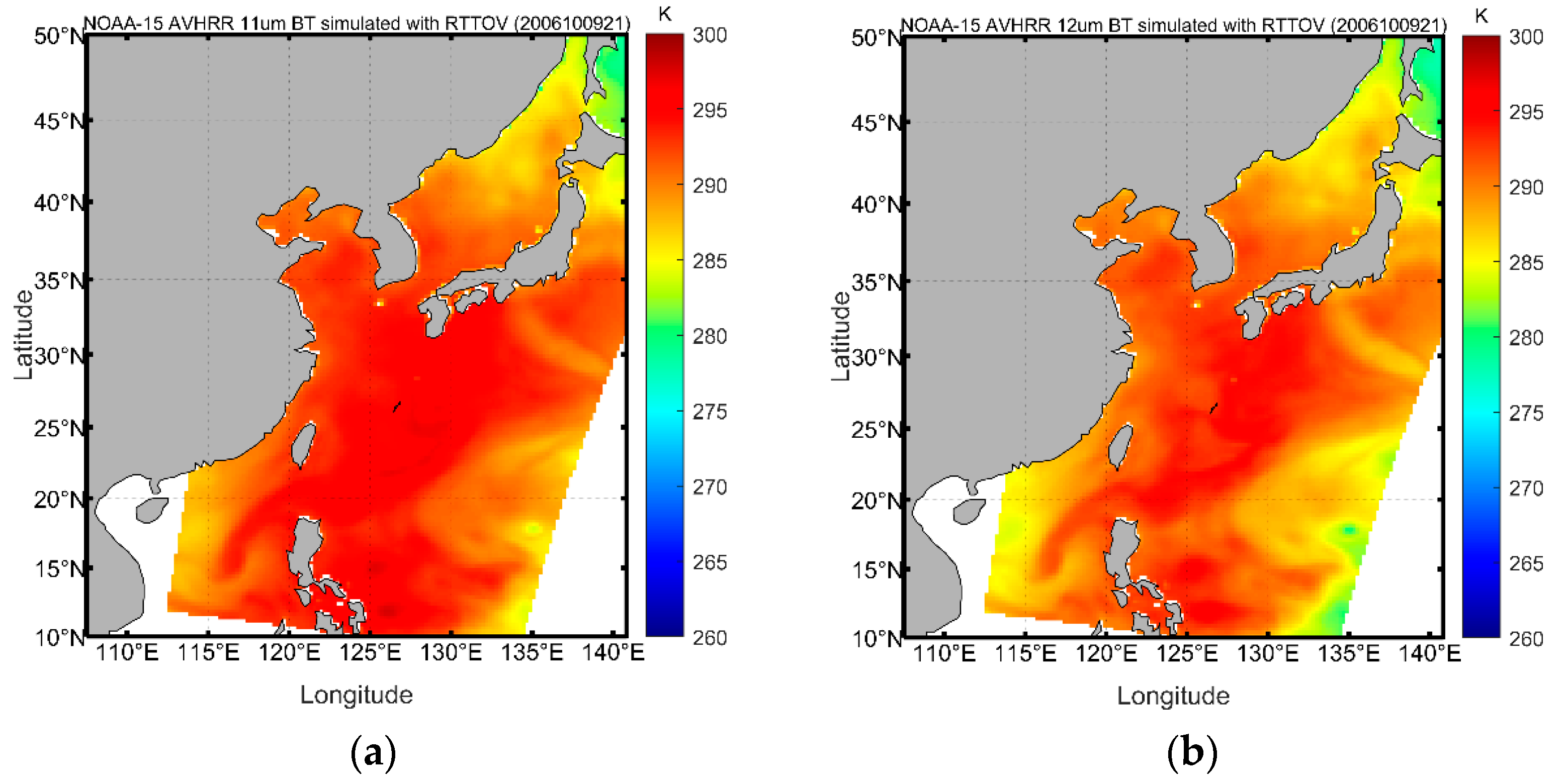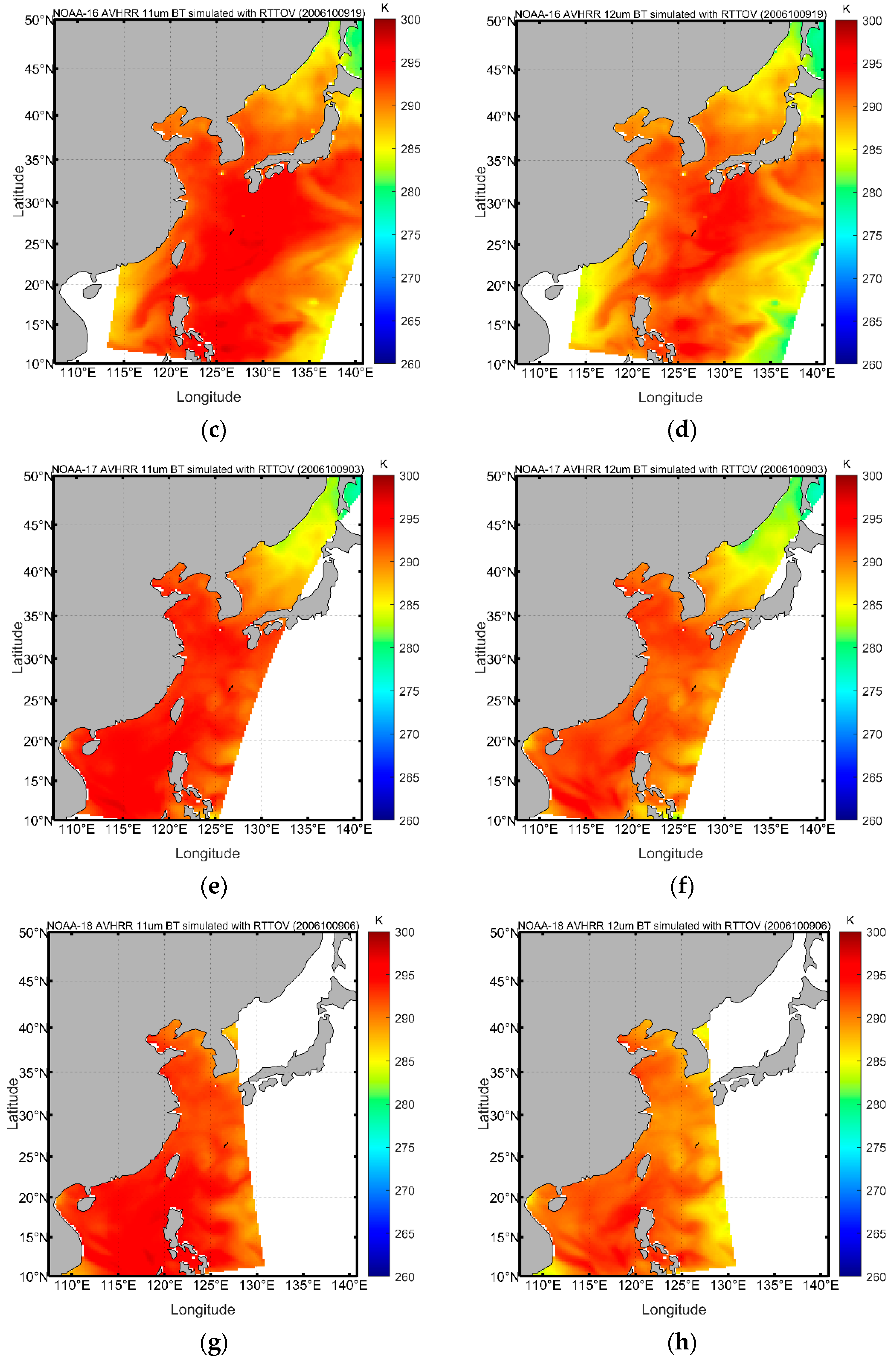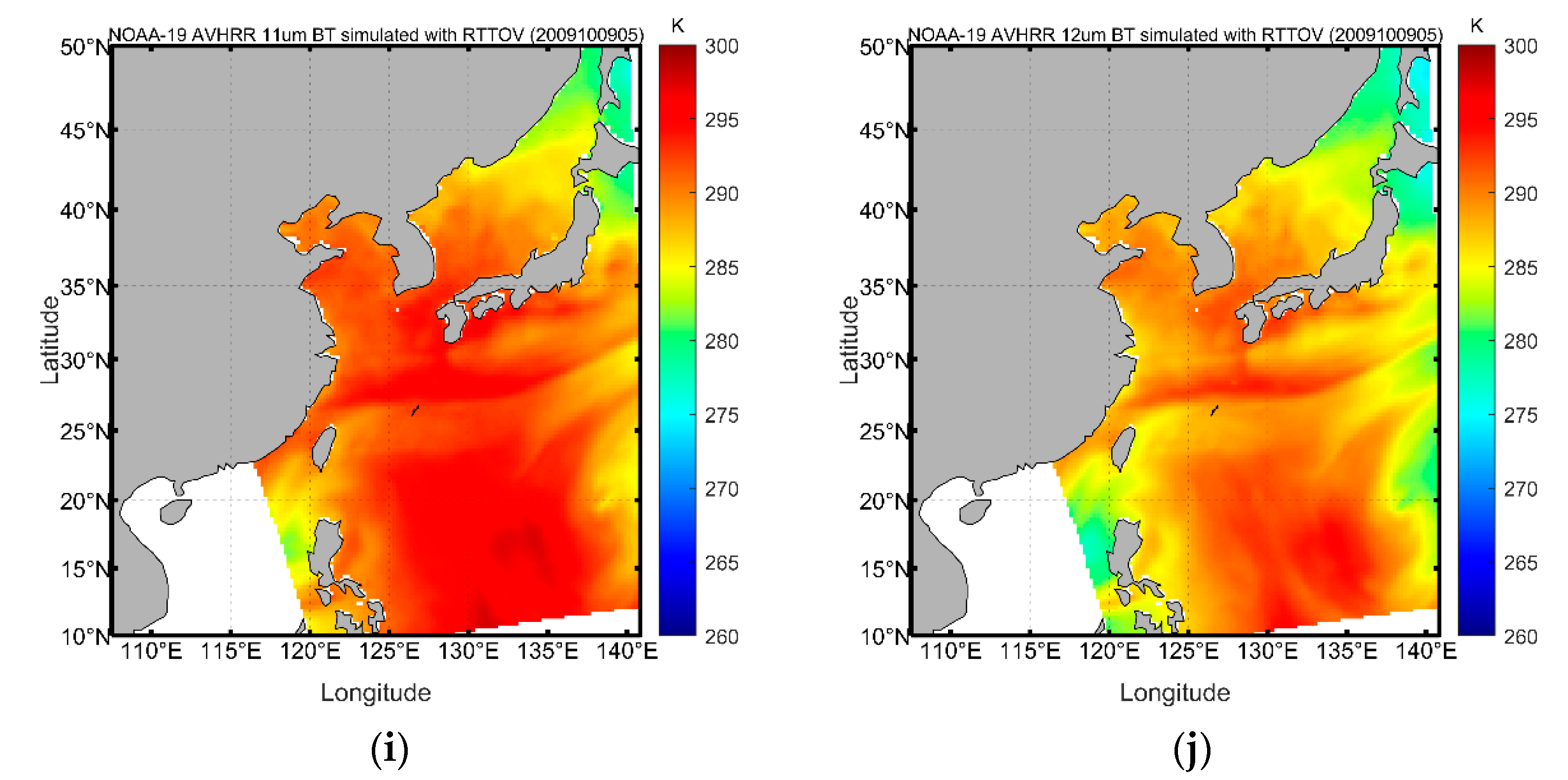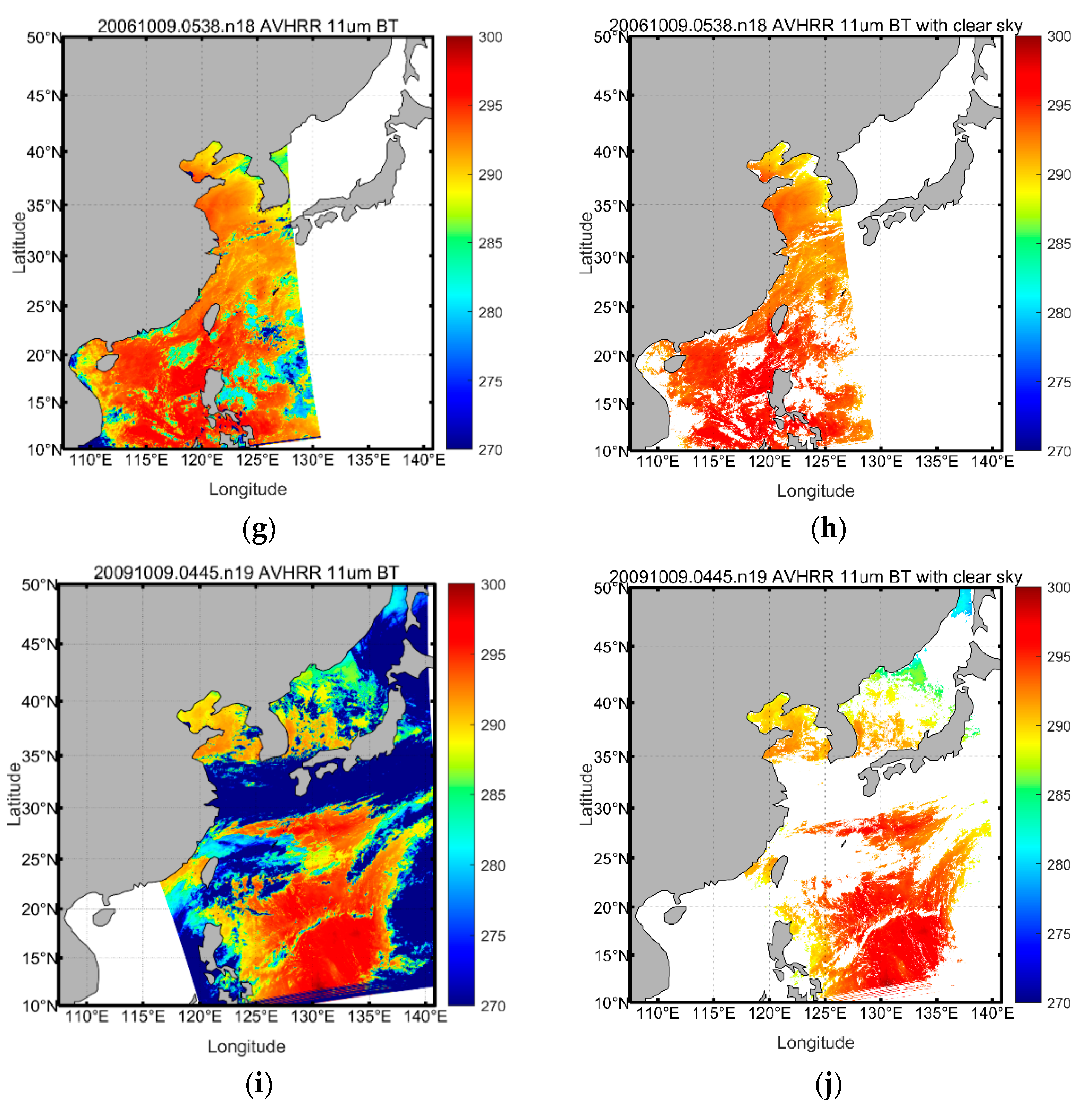Retrieval of Sea Surface Skin Temperature from the High Resolution Picture Transmission Data of the National Oceanic and Atmospheric Administration Series Satellites
Abstract
:1. Introduction
2. Materials and Methods
2.1. Data
2.1.1. NOAA/AVHRR Data
2.1.2. In Situ Data
2.1.3. ERA5 Data
2.2. Methods
2.2.1. Simulation Using the Atmospheric Radiative Transfer Model
2.2.2. Cloud Detection
2.2.3. SST Retrieval
3. Results
4. Discussion
5. Conclusions
Author Contributions
Funding
Data Availability Statement
Acknowledgments
Conflicts of Interest
References
- Martin, S. An Introduction to Ocean Remote Sensing; Cambridge University Press: Cambridge, UK, 2014. [Google Scholar]
- Cracknell, A.P. The Advanced Very High Resolution Radiometer; CRC Press: London, UK, 1997; ISBN 9780748402090. [Google Scholar]
- Bhatt, R.; Doelling, D.R.; Scarino, B.R.; Gopalan, A.; Haney, C.O.; Minnis, P.; Bedka, K.M. A Consistent AVHRR Visible Calibration Record Based on Multiple Methods Applicable for the NOAA Degrading Orbits. Part I: Methodology. J. Atmos. Ocean. Technol. 2016, 33, 2499–2515. [Google Scholar] [CrossRef]
- Kilpatrick, K.A.; Podestá, G.P.; Evans, R. Overview of the NOAA/NASA Advanced Very High Resolution Radiometer Pathfinder Algorithm for Sea Surface Temperature and Associated Matchup Database. J. Geophys. Res. 2001, 106, 9179–9197. [Google Scholar] [CrossRef]
- Walton, C.C.; Pichel, W.G.; Sapper, J.F.; May, D.A. The Development and Operational Application of Nonlinear Algorithms for the Measurement of Sea Surface Temperatures with the NOAA Polar-Orbiting Environmental Satellites. J. Geophys. Res. Ocean. 1998, 103, 27999–28012. [Google Scholar] [CrossRef]
- Casey, K.S.; Brandon, T.B.; Cornillon, P.; Evans, R. The Past, Present and Future of the AVHRR Pathfinder SST Program. In Oceanography from Space; Springer: Dordrecht, The Netherlands, 2010; pp. 273–287. [Google Scholar]
- Saha, K.; Zhao, X.; Zhang, H.M.; Casey, K.S.; Zhang, D.; Baker-Yeboah, S.; Kilpatrick, K.A.; Evans, R.H.; Ryan, T.; Relph, J.M. AVHRR Pathfinder Version 5.3 Level 3 Collated (L3C) Global 4 km Sea Surface Temperature for 1981-Present; NOAA National Centers for Environmental Information: Asheville, NC, USA, 2018.
- Qiu, C.H.; Wang, D.X.; Kawamura, H.; Guan, L.; Qin, H.L. Validation of AVHRR and TMI-Derived Sea Surface Temperature in the Northern South China Sea. Cont. Shelf Res. 2009, 29, 2358–2366. [Google Scholar] [CrossRef]
- Rayner, N.; Good, S.; Block, T.; Evadzi, P.; Embury, O. SST CCI Phase-II SST CCI Product User Guide; SST_CCI-PUG-UKMO-201. 2019. Available online: https://climate.esa.int/media/documents/SST_cci_PUG_v2.pdf (accessed on 8 April 2019).
- Merchant, C.J.; Embury, O.; Bulgin, C.E.; Block, T.; Corlett, G.K.; Fiedler, E.; Good, S.A.; Mittaz, J.; Rayner, N.A.; Berry, D.; et al. Satellite-Based Time-Series of Sea-Surface Temperature Since 1981 for Climate Applications. Sci. Data 2019, 6, 223. [Google Scholar] [CrossRef] [PubMed] [Green Version]
- Lee, M.A.; Chang, Y.; Sakaida, F.; Kawamura, H.; Cheng, C.H.; Chan, J.W.; Huang, I. Validation of Satellite-Derived Sea Surface Temperatures for Waters around Taiwan. Terr. Atmos. Ocean. Sci. 2005, 16, 1189–1204. [Google Scholar] [CrossRef] [Green Version]
- Park, K.A.; Lee, E.Y.; Chung, S.R.; Sohn, E.H. Accuracy Assessment of Sea Surface Temperature from NOAA/AVHRR Data in the Seas around Korea and Error Characteristics. Korean J. Remote Sens. 2011, 27, 663–675. [Google Scholar] [CrossRef]
- Park, K.A.; Lee, E.Y.; Li, X.F.; Chung, S.R.; Sohn, E.H.; Hong, S. NOAA/AVHRR sea surface temperature accuracy in the East/Japan Sea. Int. J. Digit. Earth 2015, 8, 784–804. [Google Scholar] [CrossRef]
- Ignatov, A.; Zhou, X.J.; Petrenko, B.; Liang, X.M.; Kihai, Y.; Dash, P.; Stroup, J.; Sapper, J.; DiGiacomo, P. AVHRR GAC SST Reanalysis Version 1 (RAN1). Remote Sens. 2016, 8, 315. [Google Scholar] [CrossRef] [Green Version]
- Bulgin, C.E.; Mittaz, J.P.D.; Embury, O.; Eastwood, S.; Merchant, C.J. Bayesian Cloud Detection for 37 Years of Advanced Very High Resolution Radiometer (AVHRR) Global Area Coverage (GAC) Data. Remote Sens. 2018, 10, 97. [Google Scholar] [CrossRef] [Green Version]
- Minnett, P.J.; Kaiser-Weiss, A.K. Group for High Resolution Sea-Surface Temperature Discussion Document: Near-Surface Oceanic Temperature Gradients. 2012. Available online: https://www.ghrsst.org/wp-content/uploads/2021/04/SSTDefinitionsDiscussion.pdf (accessed on 6 September 2020).
- Xu, F.; Ignatov, A. In Situ SST Quality Monitor (iQuam). J. Atmos. Ocean. Technol. 2014, 31, 164–180. [Google Scholar] [CrossRef]
- Xu, F.; Ignatov, A. Evaluation of In Situ Sea Surface Temperatures for Use in the Calibration and Validation of Satellite Retrievals. J. Geophys. Res. 2010, 115, C09022. [Google Scholar] [CrossRef]
- Hersbach, H.; Bell, B.; Berrisford, P.; Hirahara, S.; Horányi, A.; Muñoz-Sabater, J.; Nicolas, J.; Peubey, C.; Radu, R.; Schepers, D.; et al. The ERA5 Global Reanalysis. Q. J. R. Meteorol. Soc. 2020, 146, 1999–2049. [Google Scholar] [CrossRef]
- Saunders, R.; Hocking, J.; Turner, E.; Rayer, P.; Rundle, D.; Brunel, P.; Vidot, J.; Roquet, P.; Matricardi, M.; Geer, A.; et al. An Update on the RTTOV Fast Radiative Transfer Model (Currently at Version 12). Geosci. Model Dev. 2018, 11, 2717–2737. [Google Scholar] [CrossRef] [Green Version]
- Merchant, C.J.; Old, C.; Embury, O.; MacCallum, S. Generalized Bayesian Cloud Screening; Algorithm Theoretical Basis Version 2.1; School of Geosciences: Edinburgh, UK, 2008. [Google Scholar]
- Pearson, K.; Embury, O.; Bulgin, C. Bayesian Cloud Detection Algorithm Theoretical Basis Document. 2014. Available online: https://www-cdn.eumetsat.int/files/2020-04/pdf_bay_clo_atbd.pdf (accessed on 20 November 2014).
- SST CCI Auxiliary Datasets. Available online: https://zenodo.org/record/2586714#.YGWWWa8zaUk (accessed on 7 April 2021).
- Merchant, C.J.; Le Borgne, P.; Marsouin, A.; Roquet, H. Optimal Estimation of Sea Surface Temperature from Split-Window Observations. Remote Sens. Environ. 2008, 112, 2469–2484. [Google Scholar] [CrossRef]
- Merchant, C.J.; Le Borgne, P.; Roquet, H.; Marsouin, A. Sea Surface Temperature from a Geostationary Satellite by Optimal Estimation. Remote Sens. Environ. 2009, 113, 445–457. [Google Scholar] [CrossRef]
- Merchant, C.J.; Le Borgne, P.; Roquet, H.; Legendre, G. Extended Optimal Estimation Techniques for Sea Surface Temperature from the Spinning Enhanced Visible and Infra-Red Imager (SEVIRI). Remote Sens. Environ. 2013, 131, 287–297. [Google Scholar] [CrossRef]
- Donlon, C.J.; Minnett, P.J.; Gentemann, C.; Nightingale, T.J.; Barton, I.J.; Ward, B.; Murray, M.J. Toward Improved Validation of Satellite Sea Surface Skin Temperature Measurements for Climate Research. J. Clim. 2002, 14, 353–369. [Google Scholar] [CrossRef]
- Dash, P.; Ignatov, A.; Kihai, Y.; Sapper, J. The SST Quality Monitor (SQUAM). J. Atmos. Ocean. Technol. 2010, 27, 1899–1917. [Google Scholar] [CrossRef]
- Chen, Y.; Qu, L.Q.; Guan, L. Evaluation of NOAA/AVHRR Sea Surface Temperature at Full HRPT Resolution in the Northwest Pacific Ocean. J. Ocean Univ. China 2021, 20, 1431–1439. [Google Scholar] [CrossRef]














| Satellite | Orbit | Time (Month/Day/Year) |
|---|---|---|
| NOAA-15 | AM | 1 January 2005 to 31 December 2009 |
| NOAA-16 | PM | 1 January 2005 to 31 December 2006 |
| NOAA-17 | AM | 1 January 2005 to 31 December 2009 |
| NOAA-18 | PM | 3 September 2005 to 31 December 2009 |
| NOAA-19 | PM | 23 July 2009 to 31 December 2009 |
| Satellite | Time | Numbers | Min (°C) | Max (°C) | Bias (°C) | SD (°C) | Median (°C) | RSD (°C) |
|---|---|---|---|---|---|---|---|---|
| NOAA-15 | Day | 4786 | −1.35 | 1.03 | −0.16 | 0.42 | −0.15 | 0.39 |
| Night | 4582 | −1.28 | 1.12 | −0.08 | 0.41 | −0.08 | 0.39 | |
| NOAA-16 | Day | 1803 | −1.96 | 1.39 | −0.32 | 0.60 | −0.28 | 0.56 |
| Night | 1981 | −1.86 | 1.53 | −0.26 | 0.60 | −0.14 | 0.56 | |
| NOAA-17 | Day | 6574 | −1.13 | 1.30 | 0.08 | 0.41 | 0.09 | 0.40 |
| Night | 7264 | −1.24 | 1.20 | −0.02 | 0.42 | −0.01 | 0.40 | |
| NOAA-18 | Day | 4992 | −1.20 | 0.92 | −0.15 | 0.36 | −0.14 | 0.35 |
| Night | 5442 | −1.18 | 1.04 | −0.08 | 0.37 | −0.07 | 0.36 | |
| NOAA-19 | Day | 1257 | −1.22 | 0.97 | −0.13 | 0.36 | −0.12 | 0.37 |
| Night | 989 | −1.00 | 0.84 | −0.10 | 0.33 | −0.08 | 0.30 |
| Satellite | Time | Numbers | Min (°C) | Max (°C) | Bias (°C) | SD (°C) | Median (°C) | RSD (°C) |
|---|---|---|---|---|---|---|---|---|
| NOAA-15 | Day | 6099 | −2.30 | 2.10 | −0.15 | 0.76 | −0.05 | 0.67 |
| Night | 8011 | −2.70 | 2.10 | −0.33 | 0.82 | −0.25 | 0.74 | |
| NOAA-16 | Day | 1810 | −2.55 | 1.80 | −0.38 | 0.75 | −0.35 | 0.67 |
| Night | 5014 | −3.00 | 1.80 | −0.64 | 0.84 | −0.55 | 0.82 | |
| NOAA-17 | Day | 6543 | −1.85 | 1.65 | −0.10 | 0.64 | −0.10 | 0.59 |
| Night | 15534 | −2.50 | 1.90 | −0.37 | 0.76 | −0.30 | 0.74 | |
| NOAA-18 | Day | 4970 | −2.25 | 1.75 | −0.25 | 0.69 | −0.20 | 0.67 |
| Night | 11279 | −2.65 | 1.75 | −0.52 | 0.78 | −0.45 | 0.74 | |
| NOAA-19 | Day | 1197 | −1.55 | 1.55 | −0.02 | 0.55 | 0.00 | 0.52 |
| Night | 2078 | −2.15 | 1.85 | −0.23 | 0.67 | −0.15 | 0.67 |
Disclaimer/Publisher’s Note: The statements, opinions and data contained in all publications are solely those of the individual author(s) and contributor(s) and not of MDPI and/or the editor(s). MDPI and/or the editor(s) disclaim responsibility for any injury to people or property resulting from any ideas, methods, instructions or products referred to in the content. |
© 2023 by the authors. Licensee MDPI, Basel, Switzerland. This article is an open access article distributed under the terms and conditions of the Creative Commons Attribution (CC BY) license (https://creativecommons.org/licenses/by/4.0/).
Share and Cite
Chen, Y.; Qu, L.; Li, Z.; Guan, L. Retrieval of Sea Surface Skin Temperature from the High Resolution Picture Transmission Data of the National Oceanic and Atmospheric Administration Series Satellites. Remote Sens. 2023, 15, 3723. https://doi.org/10.3390/rs15153723
Chen Y, Qu L, Li Z, Guan L. Retrieval of Sea Surface Skin Temperature from the High Resolution Picture Transmission Data of the National Oceanic and Atmospheric Administration Series Satellites. Remote Sensing. 2023; 15(15):3723. https://doi.org/10.3390/rs15153723
Chicago/Turabian StyleChen, Yan, Liqin Qu, Zhuomin Li, and Lei Guan. 2023. "Retrieval of Sea Surface Skin Temperature from the High Resolution Picture Transmission Data of the National Oceanic and Atmospheric Administration Series Satellites" Remote Sensing 15, no. 15: 3723. https://doi.org/10.3390/rs15153723
APA StyleChen, Y., Qu, L., Li, Z., & Guan, L. (2023). Retrieval of Sea Surface Skin Temperature from the High Resolution Picture Transmission Data of the National Oceanic and Atmospheric Administration Series Satellites. Remote Sensing, 15(15), 3723. https://doi.org/10.3390/rs15153723







